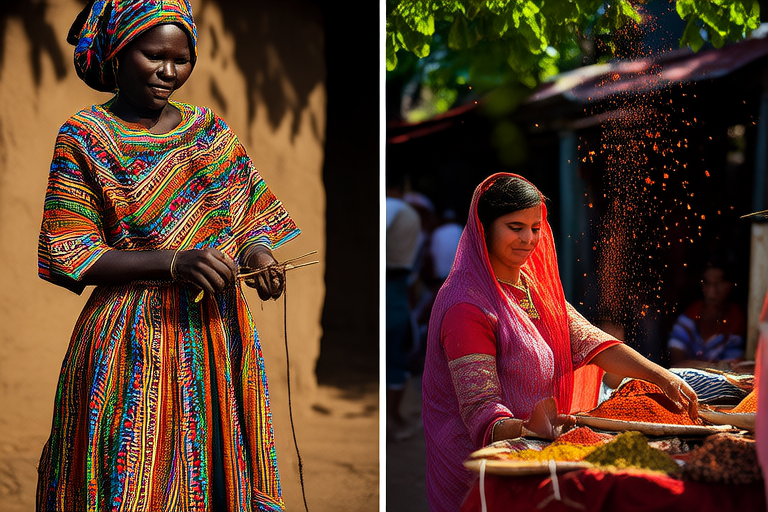Cultural Quilts: Weaving Together Global Traditions and Customs

Cultural Quilts: Weaving Together Global Traditions and Customs
Introduction
Quilts, those layered textiles stitched together with care and precision, are more than just warm bed coverings; they are a testament to human creativity and cultural heritage. Across the globe, quilts serve as practical tools for warmth and protection, yet they also encapsulate the essence of a community’s identity, history, and values. From the intricate patchwork of African Kente cloths to the bold, geometric patterns of Amish quilts, quilts tell stories of resilience, tradition, and connection. This article explores the rich tapestry of quilting traditions worldwide, highlighting their historical context, regional variations, and enduring cultural significance.
Historical Context
The history of quilting spans millennia and encompasses numerous civilizations. In ancient Egypt, linen wraps were used to preserve mummies, while in China, silk was embroidered to create elaborate ceremonial garments. By the Middle Ages, European monasteries were producing finely crafted quilts for nobility. The practice spread through trade routes, adapting to local materials and techniques. In the United States, quilting became particularly significant during the colonial era and the Civil War, serving as both a practical necessity and a means of artistic expression.
Quilting also played a crucial role in the Underground Railroad, where coded patterns on quilts helped guide enslaved individuals to freedom. These patterns, such as the Flying Geese and the Log Cabin, symbolized directions and safe houses. The tradition continued to evolve, with each generation adding its own innovations and interpretations.
Regional Traditions
Africa: The Vibrant Colors of Kente Cloth
In West Africa, particularly Ghana and Benin, Kente cloth is a celebrated textile known for its bright colors and bold patterns. Woven by hand on narrow looms, Kente cloths are often used to make ceremonial robes and blankets. Each color and pattern holds symbolic meaning, reflecting themes such as royalty, wisdom, and spirituality. The process of weaving Kente is highly ritualistic, passed down through generations, and continues to be a vital part of African cultural identity.
North America: The Patchwork of American Quilts
American quilts have a rich history, with roots tracing back to colonial times. Early settlers made utilitarian quilts from scraps of fabric, creating functional yet beautiful pieces. During the 19th century, quilt-making became a popular pastime for women, leading to the development of distinctive styles like the Baltimore Album and the Log Cabin. These quilts often featured intricate appliqué work and detailed embroidery, showcasing the skill and creativity of their makers. Today, quilting remains a vibrant art form, with modern quilters pushing boundaries and experimenting with new materials and techniques.
Asia: The Intricate Artistry of Japanese Chirimen
In Japan, the art of quilting is exemplified by chirimen, a type of crepe fabric known for its soft texture and elegant drape. Chirimen quilts, often featuring floral motifs and subtle gradients, are prized for their delicate beauty. The process involves layering thin sheets of chirimen with batting and hand-stitching them together using fine silk thread. This technique requires immense patience and precision, making chirimen quilts true works of art. They are frequently used in traditional clothing and home decor, embodying the refined aesthetics of Japanese culture.
Europe: The Precision of Amish Quilts
Amish quilts, originating from Pennsylvania Dutch communities, are renowned for their simplicity and geometric precision. Using only solid colors and minimal embellishments, Amish quilters create stunningly beautiful pieces that reflect their commitment to modesty and craftsmanship. The most common patterns include the Double Wedding Ring, the Nine-Patch, and the Bars. These quilts are not only functional but also serve as a visual representation of the Amish way of life, emphasizing harmony and balance.
Social and Cultural Significance
Quilts have long been used as a medium for storytelling, community building, and preserving heritage. In many cultures, quilting bees bring people together, fostering a sense of belonging and shared purpose. These gatherings provide opportunities for women to exchange ideas, share techniques, and strengthen bonds. Additionally, quilts often carry personal and collective histories, serving as tangible reminders of family traditions and cultural practices. Through their designs and materials, quilts offer insights into the lives, beliefs, and experiences of the people who created them.
Modern Interpretations
Contemporary artists and designers are reimagining traditional quilt-making techniques in innovative ways. Some are experimenting with unconventional materials, such as recycled plastics and digital prints, to address environmental concerns and explore new aesthetic possibilities. Others are blending diverse cultural influences, creating hybrid quilts that celebrate cross-cultural dialogue and collaboration. These modern interpretations challenge conventional notions of quilting, expanding its reach and relevance in today’s globalized world.
Conclusion
Quilts are a universal language that transcends borders and generations, connecting people through shared experiences and values. Whether used for practical purposes or artistic expression, quilts continue to play a vital role in shaping and preserving cultural identities. As we explore the rich diversity of quilting traditions worldwide, we gain a deeper understanding of the human spirit and its capacity for creativity and resilience. Let us cherish and celebrate this timeless art form, recognizing its power to inspire and unite.